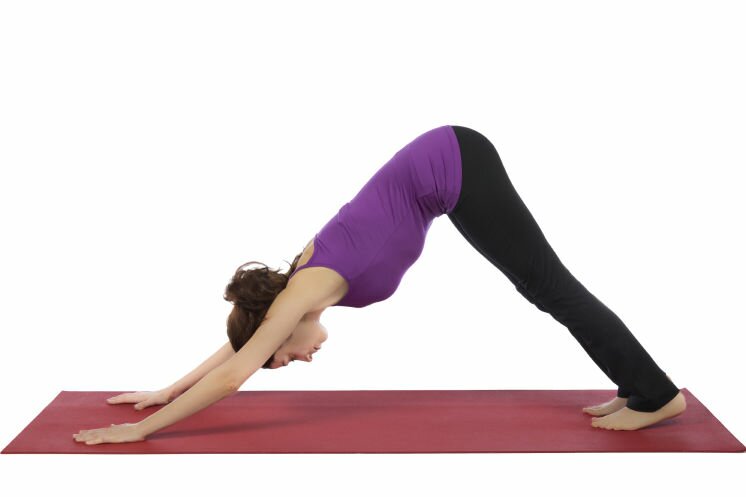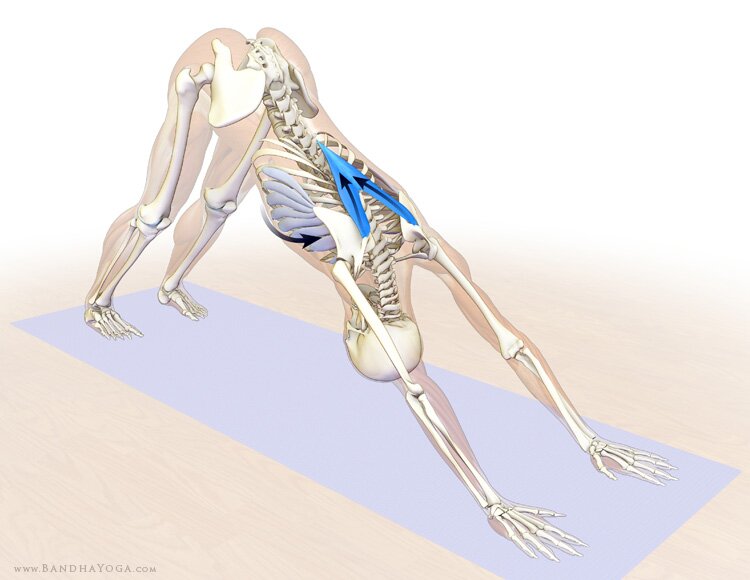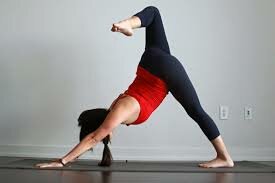- Begin on your hands and knees on all fours with wrists 6 to 12 inches in front of shoulders. Separate knees hip-width apart and curl toes under. Align your wrists directly under your shoulders and your knees directly under your hips. The fold of your wrists should be parallel with the top edge of your yoga mat. Point your middle fingers directly to the top edge of your mat.
- Stretch your elbows and relax your upper back.
- Spread your fingers wide and press firmly through your palms and knuckles. Distribute your weight evenly across your hands. Pushing evenly into palms, lift knees off floor. Lift your tailbone toward ceiling and push top of thighs back so body looks like an inverted V.
- Exhale as you tuck your toes and lift your knees off the floor. At first, keep knees bent and heels lifted off floor. Slowly start to straighten knees, but don’t lock them .Reach your pelvis up toward the ceiling, then draw your sit bones toward the wall behind you. Gently begin to straighten your legs, but do not lock your knees. Bring your body into the shape of an “A.” Imagine your hips and thighs being pulled backwards from the top of your thighs. Do not walk your feet closer to your hands.
- Press the floor away from you as you lift through your pelvis. As you lengthen your spine, lift your sit bones up toward the ceiling. Now press down equally through your heels and the palms of your hands.
- Firm the outer muscles of your arms and press your index fingers into the floor. Lift from the inner muscles of your arms to the top of both shoulders. Draw your shoulder blades into your upper back ribs and toward your tailbone. Broaden across your collarbones.
- Rotate your arms externally so your elbow creases face your thumbs.
- Draw your chest toward your thighs as you continue to press the mat away from you, lengthening and decompressing your spine.
- Engage your quadriceps. Rotate your thighs inward as you continue to lift your sit bones high. Sink your heels toward the floor.
- Gently move chest back toward thighs until ears are even with upper arms; don’t let head dangle. Keep hips lifting and push strongly into hands.
- Hold for 5-10 breaths (or to your liking).
- To release, exhale as you gently bend your knees and come back to your hands and knees.
Some Modifications For You To Try
Since Downward-Facing Dog is performed so often during Ashtanga Vinyasa and Power Yoga Classes, it’s important to learn how to do these poses correctly to avoid injury and fatigue during your practice. Try these simple changes to find a variation that works best for you during your practice:
- To correctly learn the spine-lengthening aspect of Downward Dog, you need to first bend your knees in the pose, coming onto the balls of your feet. Bring your shins parallel to the mat and keep your sit bones lifting high and back. Press your hips toward the wall behind you if possible and then slowly begin to straighten your legs.
- For a greater challenge, lift your right leg as high as possible, reaching through the heel. Keeping your right leg lifted, extend your left arm behind you. Rest the back of your hand on your low back. Repeat on the other side.
- For a restorative version of the pose, place a yoga block under your head. Release all neck tension. Hold for up to five minutes or until your liking. Be careful that the block doesn’t slip to avoid accident.
- Place a yoga block between your inner thighs to learn the movement of inner rotation. Grip the block with your thighs and press it toward the wall behind you as you hold the pose and practice this to get more comfortable.
Yoga Guide Tips
When done correctly, Downward Dog can greatly benefit the whole body. Keep the following information in mind when practicing this pose:
- If you are very flexible, do not let your rib cage sink toward the floor. Draw your lower ribs in and maintain a flat back when doing this pose.
- Your heels do not need to touch the ground. Maintain the length of your spine and the lift of your pelvis.
Practicing this yoga pose will not only warm and strengthen your body, but will provide an entire stretch for you and can be used as a transitional pose (between other poses), or as a full-body stretch on its own. Try a few rounds of Downward Dog during your day to increase blood flow and energy while calming your mind, even while at work or just in your every day routine. This is a great way to easily relax and do yoga every day in your busy life.
Watch the video below to learn more and how to properly perform Downward Dog pose:













Very good information. Lucky me I recently found your site by accident (stumbleupon). I have bookmarked it for later!